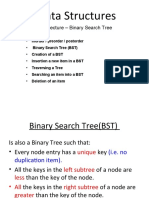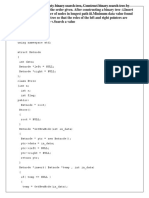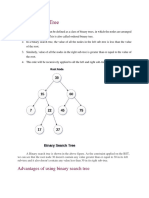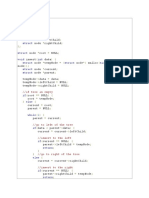0% found this document useful (0 votes)
22 views9 pagesCODE4
The document contains C++ code for a binary search tree (BST) implementation, including functions for inserting nodes, finding the longest path, finding the minimum value, swapping left and right pointers, searching for a value, and displaying the tree. The main function provides a user interface to interact with the BST through various options. The code demonstrates basic operations on a BST, allowing users to manipulate and query the tree structure.
Uploaded by
eshwaribhandkarCopyright
© © All Rights Reserved
We take content rights seriously. If you suspect this is your content, claim it here.
Available Formats
Download as DOCX, PDF, TXT or read online on Scribd
0% found this document useful (0 votes)
22 views9 pagesCODE4
The document contains C++ code for a binary search tree (BST) implementation, including functions for inserting nodes, finding the longest path, finding the minimum value, swapping left and right pointers, searching for a value, and displaying the tree. The main function provides a user interface to interact with the BST through various options. The code demonstrates basic operations on a BST, allowing users to manipulate and query the tree structure.
Uploaded by
eshwaribhandkarCopyright
© © All Rights Reserved
We take content rights seriously. If you suspect this is your content, claim it here.
Available Formats
Download as DOCX, PDF, TXT or read online on Scribd
/ 9























































































